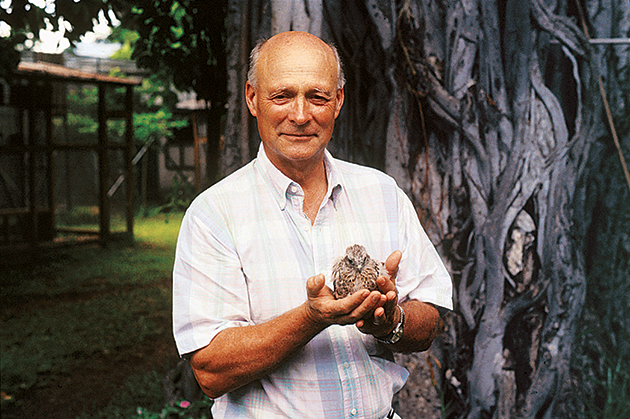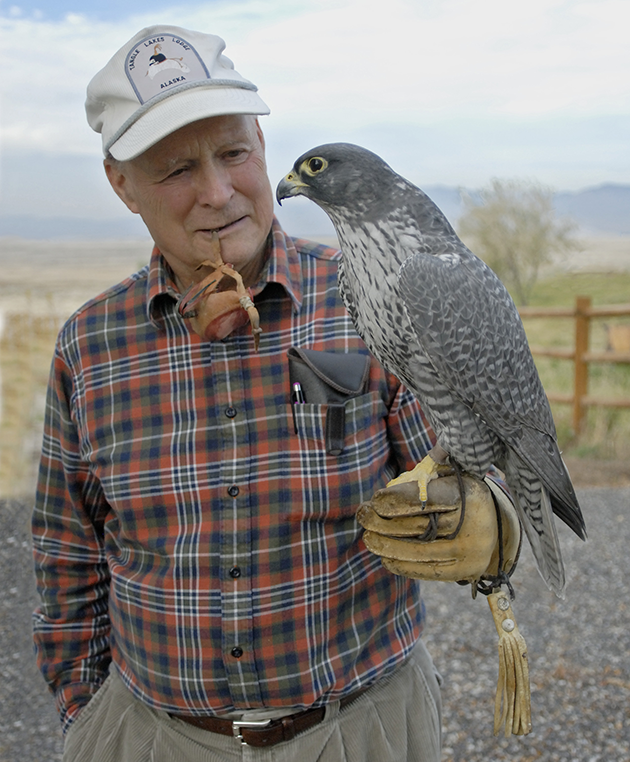
Author Sherrida Woodley thinks deeply about dearly departed birds. such as California Condors and Passenger Pigeons. She also has an abiding interest in important figures in natural history. She’s already written about Rachel Carson: Secret Birder. Now, Sherri turns her attention to an ornithologist with a soft spot for raptors…
The boy pushed through scrub mesquite following a trail strangely different from the rest of his grandfather’s land. This wasn’t a place for the inexperienced. Thorns, some of them an inch long, could pierce anything he wore, even his shoes. Creatures that crawled, or worse, slithered, would lie in the bottoms, pressed into shade and invisibility. He had worked this draw before and knew its silence, even in early morning. The only reason he kept coming back was hidden from the rest of the world, except for those survivors too lethal to die. He came for the hawks.
This was the world of Tom Cade early in the last century. Raised in and around the West Texas steppe country where temperatures reached 100 degrees with regularity, he began life as the Dust Bowl and Great Depression converged. His parents moved where opportunity beckoned, taking him from San Angelo, Texas, to Columbus, New Mexico, then to Dallas, and finally on to California. But for a while one constant in his life was his grandfather’s farm, a far-off stretch of land in Comanche County, Texas. It was there where the first glimpse of his future began.
That summer of 1938, when he was ten years old, Cade read of two brothers, Frank and John Craighead, who wrote of their experiences with falcons in National Geographic. Curious and inventive, he figured out he didn’t need their assistance, just their instructions to help him capture and train a young Cooper’s Hawk. An eyas was what he was after that day he worked the Texas draw, a young nestling about to fly. He had stalked the nest for days, waiting for just the right time when she would be on the verge of fledging, then took her into his care. Inexperienced, perhaps overly confident, he didn’t know she was one of the wildest of hawks to train. But he tried, using the Craigheads’ techniques, and he learned from that young bird, and eventually many others along the way.
Tom Cade, a quiet, down-to-earth ornithologist, more than once remarked that falconry is really just another form of bird watching. His life brought him into close proximity with birds, observing them and practicing taxidermy to learn even more. He watched them perhaps excessively, internalizing their habits and conformation. But it wasn’t until he studied falconry’s appeal to centuries-old cultures–the Persians, English, Dutch, French, Chinese, Russians, and people of the Middle East–that Cade realized the sport of kings was slowly dying and would disappear along with the age-old mystique of a raptor returning to the human who trained her. The concern possessed him.
“It was all in books,” he would later admit. “I didn’t have any instruction from anybody. I knew no falconers. Just did it on my own from what I read.” Falcons could be taken from the nest just before they were able to fly or caught wild after maturity. Nestlings weren’t taken until their down had been replaced by feathers. It was advisable to remove them at night, to keep them calm, to establish immediately a feeding board on which they would be fed chopped beef and egg to start, then fresh birds, rabbit or squirrel. Except for the falconer’s jesses and bell, they were to be allowed freedom to pursue life in the wild, life with minimal human contact. This in-between world of freedom supplemented with food from an undetected source was known as hacking. And hacking would, in time, become the basis of saving one of the most endangered raptors on earth–the Peregrine Falcon.
There is much more to gentling a bird governed by talons, a fierce beak, and laser-perfect eyesight than supplemental feeding. Done properly, a young hawk is curtailed in a growing compulsion to fly greater distances and hunt for herself by a process sometimes called “manning.” A hood is placed over the bird’s eyes immediately after capture, which takes place at the feeding board after about two weeks of free flying. Known to be calming, the hood is then used intermittently in a series of communications from man to bird–stroking, gentle speech, and small bits of food offered as the hawk accepts the gloved hand as a perch and some degree of taming is achieved. In the case of threatened Peregrine Falcons, taming was far from the goal. But the rudiments of falconry, as Tom Cade envisioned, were the only way to save them.
“I’d witnessed Peregrines and Gyrfalcons in the fall of 1949 while I was doing undergraduate work at the University of Alaska. An old curator of birds at the Los Angeles County Museum encouraged me to visit the Alaskan territory as a place abundantly populated with these birds, because even then they were becoming rare and hard to obtain.”
“What I found was that the falcon’s world moves about ten times faster than ours. A Peregrine’s stoop or dive has been measured at over 200 miles an hour, and a Gyrfalcon can give a determined, racing chase until she wears out her prey. I saw them there along the Yukon and Colville Rivers multiple times in the 1950s and early 1960s, saw them in impressive numbers.” Cade was later to comment, “1951 was when I first saw the high-flying style of hunting performed by the wilderness-inhabiting Peregrines of Alaska.” That moment stayed with him and fostered a never-ceasing interest in their longevity.

By the time Cade had finished graduate school at UCLA and received his degree in 1957, he was not only an ornithologist, but a zoologist and respected falconer as well. He spent five more summers in Alaska surveying birds, and as his academic career flourished [including a stint at Syracuse University and eventually director of the Cornell Lab of Ornithology], he considered the fate of Peregrines around the world. “The sight of those early populations in Alaska haunted me, especially as their populations fell rapidly into decline.” He reported seeing nest sites that were disappearing in California and eggs left unhatched in the nest or prematurely broken, all signs that later came to be associated with the pesticide DDT.
Cade credited the 1965 Madison [Wisconsin] Peregrine Conference with further alerting him and many others to the plight of Peregrines and other birds of prey. About falconers, he said, “They helped sound the alarm, they visited nests. And they were the ones who, at the end of the conference, decided to get together and talk about the possibility of breeding Peregrines in captivity as a way of at least saving the species from extinction.”
By 1970 the man who championed Peregrines had convinced Cornell University to build a Hawk Barn for captive breeding of these birds. Again, Cade led with solid evidence acquired through his own research. Along the way he discovered German falconer and wildlife artist, Renz Waller, who successfully bred a pair of Peregrines twice during some of the worst conditions of WW II and two American falconers, Larry Schram and Heinz Meng who were successful in breeding Peregrines from 1968 to 1971. In addition, Cade had already bred American Kestrels in captivity.
He returned to the Colville and Yukon Rivers and found numbers of birds still decreasing, but by then banning of DDT had coincided with the first hatches of captive- bred Peregrines. Cade was convinced the ancient practice of hacking was the breakthrough needed to reverse looming extinction. Safe feeding zones provided to young birds as they left the nest to become independent feeders and disperse naturally within a month of first flying held the promise of steadily growing numbers. And grow they did. Between 1974 and 2005, more than 7000 young Peregrines were hacked in the United States and Canada. By 1999, the Peregrine Falcon was removed from the U.S. Endangered Species List, giving it free reign to wander and populate North America in ever increasing numbers, including a nest on the ledge of the U.S. Fidelity And Guaranty home office building in Baltimore, Maryland. Today, Peregrine populations have rebounded, and, according to Cade, “are practically everywhere.” The ornithologist accomplished an invaluable mission, certainly with help, but in the same spirit he possessed as a child. When he had to, he wasn’t afraid of going it alone.
In the years that followed, Tom Cade worked with various birds of prey through two revered organizations, The Peregrine Fund and The World Center for Birds of Prey, linked in one sanctuary at the edges of Boise, Idaho. He was the founder of both and a devoted keeper of the spirit of threatened raptors the world over, including the California Condor, which also underwent captivity in order to survive. Through these organizations he still influences the international community of those who appreciate raptors, especially falconers. He never forgot the men and women who helped him accomplish such amazing strides in bird conservation.
Finally, there came a time when the ornithologist once again devoted himself to the falconer’s highest call–communion with a favored raptor. Kumpan, a Gyrfalcon, became his companion and accomplice in the world of inseparable flight between man and bird. The largest of the falcons, Cade often set Kumpan loose over the high desert of the Snake River country in Idaho, saying it gave him great pleasure to watch the Gyr climb. He described one day in mid-March:
“I flew my old gyrkin, Kumpan today. Bright sun, 65 degrees F., slight wind from the N.W. He went up on two excursions, about ten minutes each time, flying around at elevations of 500 to 1000 feet but making no contact with other birds. While resting on top of my SUV after his second flight, he suddenly took off flying hard and low over the ground to the southeast, a sure sign that he had spotted something flying in the distance. At about one mile out he started climbing into the sky and quickly made contact with two prairie falcons that were circling about 500 or more feet altitude. The birds started swooping at each other as they rose higher in the air. . . They finally disappeared from my vision. The only contact I had left with my bird was the sound of his transmitter beeping from the receiver in my hand. After about ten minutes the signal started getting louder, and soon he came shooting down to land on the SUV. Such spectacular flying occurs about once in a hundred encounters,” he wrote. “But it is what keeps falconers going for more.”
Not long after that flight Kumpan died. It was the loss of a friend and companion, a bird that symbolized Tom Cade’s lifelong affection for wilderness and the falcons that drew him there. No one listened to them quite as intently as he did. Certainly, no one envisioned an art as mysterious as falconry might save them. And for that alone, we can be sure our world is richer in the high coursing flight of Peregrines and the man who was determined to bring them into our future.
Feature photo of Tom Cade with Mauritius Kestrel by Carl Jones used by permission of The Peregrine Fund.











Leave a Comment